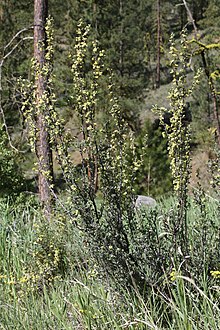Purshia tridentata
| Purshia tridentata | |
|---|---|

| |
| Purshia tridentata, Wenas Wildlife Area | |
| Scientific classification | |
| Kingdom: | Plantae |
| Clade: | Tracheophytes |
| Clade: | Angiosperms |
| Clade: | Eudicots |
| Clade: | Rosids |
| Order: | Rosales |
| Family: | Rosaceae |
| Genus: | Purshia |
| Species: | P. tridentata
|
| Binomial name | |
| Purshia tridentata (Pursh) DC.
| |
| Synonyms[1] | |
| |
Purshia tridentata, with the common name bitterbrush,[1][2][3] is a shrub in the genus Purshia of the family Rosaceae. It is native to mountainous areas of western North America.[3]
Common names include antelope bitterbrush,[3][2] antelope bush,[2] buckbrush, quinine brush, and less commonly deerbrush, blackbrush, and greasewood.[4] Some of these names are shared with other species.
Distribution[]


The plant is found from southeastern British Columbia in the north, east to Montana and Wyoming, south to New Mexico, and west in California.[3] It grows on arid mountainsides and slopes.
In California it occurs between 700–3,400 metres (2,300–11,200 ft) above sea level, including in the Peninsular Ranges, Transverse Ranges, and Sierra Nevada, and southern Cascade Range.[2][5] Further north it occurs at lower elevations, such as at 320–1,065 metres (1,050–3,494 ft) in British Columbia.[6]
Description[]
Purshia tridentata is a deciduous shrub growing to a height of 1–5 metres (3.3–16.4 ft). It has slender three- to five-lobed leaves 5–20 mm long. It is a nitrogen fixing plant.[7]
The flowers are pale yellow, with five petals 6–8 mm long, and darker yellow anthers. The fruit is a cluster of dry, slender, leathery achenes 0.6–2 cm long.
Varieties[]
There are two named varieties of the species:
- Purshia tridentata var. glandulosa — Eastern Sierra Nevada, Southern California. [8]
- Purshia tridentata var. tridentata — [9]
Uses[]
The shrub is an important forage plant for many game animals, especially during the winter.[10]
References[]
- ^ Jump up to: a b James Henrickson, "Purshia tridentata (Pursh) de Candolle, Trans. Linn. Soc. London. 12: 158. 1818", Flora of North America, 9CS1 maint: uses authors parameter (link)
- ^ Jump up to: a b c d CalFlora Database:Purshia tridentata . accessed 9.22.2013
- ^ Jump up to: a b c d "Purshia tridentata". Natural Resources Conservation Service PLANTS Database. USDA. Retrieved 16 October 2015.
- ^ United States Congressional serial set. U.S. Government Printing Office. 1861.
- ^ Brian Vanden Heuvel & Thomas J. Rosatti 2016. Purshia tridentata, in Jepson Flora Project (eds.) Jepson eFlora, accessed 19 June 2016
- ^ E-FLORA BC: Electronic Atlas of the Flora of British Columbia
- ^ David Andrews Dalton (1975). Nitrogen fixation by Purshia tridentata: some ecological aspects and root nodule anatomy. Oregon State University. Retrieved 16 November 2011.
- ^ CalFlora Database: Purshia tridentata var. glandulosa
- ^ CalFlora Database: Purshia tridentata var. tridentata
- ^ Whitney, Stephen (1985). Western Forests (The Audubon Society Nature Guides). New York: Knopf. p. 401. ISBN 0-394-73127-1.
External links[]
- Central Washington Native Plants: Antelope bitterbrush
- Range Plants of Utah: Purshia tridentata (Antelope bitterbrush)
 Media related to Purshia tridentata at Wikimedia Commons
Media related to Purshia tridentata at Wikimedia Commons
- Purshia
- Flora of the Northwestern United States
- Flora of the Southwestern United States
- Flora of British Columbia
- Flora of California
- Flora of New Mexico
- Flora of Wyoming
- Flora of the Cascade Range
- Flora of the Great Basin
- Flora of the Rocky Mountains
- Flora of the Sierra Nevada (U.S.)
- Natural history of the Peninsular Ranges
- Taxa named by Augustin Pyramus de Candolle
